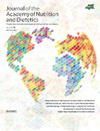Greater Frequency of Cooking Dinner at Home and More Time Spent Cooking Are Inversely Associated With Ultra-Processed Food Consumption Among US Adults
IF 3.5
2区 医学
Q2 NUTRITION & DIETETICS
Journal of the Academy of Nutrition and Dietetics
Pub Date : 2024-03-08
DOI:10.1016/j.jand.2024.03.005
引用次数: 0
Abstract
Background
Cooking at home has been promoted as a strategy to improve diet quality; however, the association between cooking behavior and ultra-processed food intake is unknown.
Objective
The objective of this study was to examine associations between frequency of cooking dinner at home and time spent cooking dinner with ultra-processed food intake.
Design
Cross-sectional, nationally representative data from the 2007-2010 National Health and Nutrition Examination Survey were analyzed.
Participants/setting
Participants were 9,491 adults (20 years and older) in the United States.
Main outcome measures
The main outcome measure was the proportion of energy intake (averaged from two 24-hour dietary recalls) from the following 4 Nova food-processing groups: (1) unprocessed or minimally processed foods, (2) processed culinary ingredients, (3) processed foods, and (4) ultra-processed foods.
Statistical analyses performed
Separate linear regression models examined associations between cooking frequency and time spent cooking dinner and proportion of energy intake from the 4 Nova food-processing groups, adjusting for sociodemographic characteristics and total energy intake.
Results
Ultra-processed foods comprised >50% of energy consumed independent of cooking frequency or time spent cooking. Higher household frequency of cooking dinner and greater time spent cooking dinner were both associated with lower intake of ultra-processed foods (P trends < .001) and higher intake of unprocessed or minimally processed foods (P trends < .001) in a dose–response manner. Compared with cooking 0 to 2 times/wk, adults who cooked dinner 7 times/wk consumed a mean of 6.30% (95% CI –7.96% to –4.64%; P < .001) less energy from ultra-processed foods. Adults who spent more than 90 minutes cooking dinner consumed 4.28% less energy from ultra-processed foods (95% CI –6.08% to –2.49%; P < .001) compared with those who spent 0 to 45 minutes cooking dinner.
Conclusions
Cooking at home is associated with lower consumption of ultra-processed foods and higher consumption of unprocessed or minimally processed foods. However, ultra-processed food intake is high among US adults regardless of cooking frequency.
在美国成年人中,在家做晚饭的频率越高、做饭的时间越长,与超加工食品的消费量成反比。
背景:家庭烹饪作为改善膳食质量的策略得到了推广:人们提倡在家烹饪作为改善饮食质量的一种策略,然而,烹饪行为与超加工食品摄入量之间的关系尚不清楚:本研究旨在探讨在家做晚饭的频率和做晚饭的时间与超加工食品摄入量之间的关系:设计:对 2007-2010 年全国健康与营养调查中具有全国代表性的横断面数据进行分析:/设置:主要结果指标:主要结果测量指标是四个 Nova 食品加工组的能量摄入比例(两次 24 小时膳食回忆的平均值):1)未加工或微量加工食品;2)加工烹饪配料;3)加工食品;4)超加工食品:分别用线性回归模型检验了烹饪频率和烹饪晚餐的时间与四种新星食品加工组能量摄入比例之间的关系,并对社会人口特征和总能量摄入进行了调整:超加工食品占能量消耗的 50%以上,与烹饪频率或烹饪时间无关。家庭烹饪晚餐的频率越高、烹饪晚餐的时间越长,超加工食品的摄入量就越低(P-趋势90 分钟烹饪晚餐所消耗的超加工食品的能量减少了 4.28%(95% CI:-6.08%,-2.49%,P结论:在家做饭可降低超加工食品的摄入量,提高未加工或微量加工食品的摄入量。然而,无论烹饪频率如何,美国成年人的超加工食品摄入量都很高。
本文章由计算机程序翻译,如有差异,请以英文原文为准。
求助全文
约1分钟内获得全文
求助全文
来源期刊

Journal of the Academy of Nutrition and Dietetics
NUTRITION & DIETETICS-
CiteScore
7.20
自引率
10.40%
发文量
649
审稿时长
68 days
期刊介绍:
The Journal of the Academy of Nutrition and Dietetics is the premier source for the practice and science of food, nutrition, and dietetics. The monthly, peer-reviewed journal presents original articles prepared by scholars and practitioners and is the most widely read professional publication in the field. The Journal focuses on advancing professional knowledge across the range of research and practice issues such as: nutritional science, medical nutrition therapy, public health nutrition, food science and biotechnology, foodservice systems, leadership and management, and dietetics education.
 求助内容:
求助内容: 应助结果提醒方式:
应助结果提醒方式:


